You may be surprised to learn that most bugs and other arthropods living in your yard do not feed on nor harm plants. Most insects pass by on a pilgrimage or simply have innocuous behaviors. Other insects will even eat and destroy whatever species of pest you have.
The are many insect predators. They include praying mantises, robber flies, hoverflies, ladybugs, ground beetles, and spiders. There are also parasitic insects that also feed on other insects. These include tachinid flies and two classes of wasps.
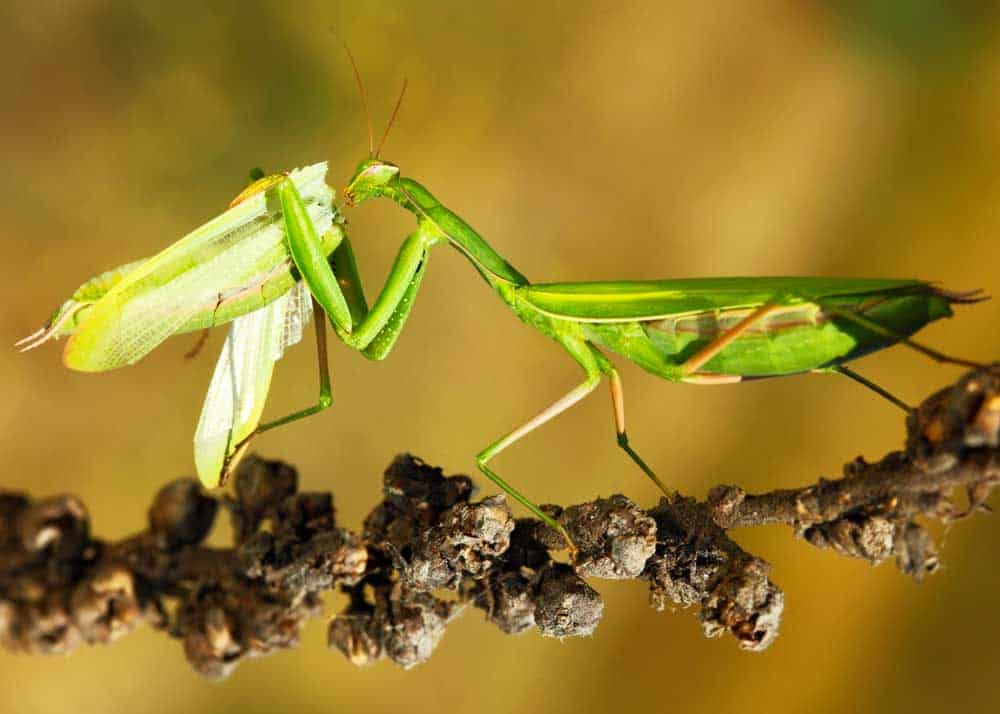
Often, these insect predators are beneficial to your yard with the potential to prevent or significantly limit the chances of a pest problem developing. Therefore, it’s essential to distinguish the beneficial arthropods from the pest to be conserved and appreciated.
These prominent allies can be classified as insect predators or insect parasites.
Table of Contents
9 Beneficial Insect Predators
Arthropods are beneficial to your yard and help limit and even prevent pest problems from developing.
Below are the most common insect predators and parasites.
1. Ladybugs
Ladybugs are often mistaken for being docile creatures, but the truth is they are formidable predator bugs!
They begin life as larvae, traveling from plant to plant, and devouring aphids. Ladybugs are more than capable of eating up to 40 aphids in an hour.
Adults and larvae both feast on many small insects with soft bodies like aphids. Ladybugs also prey on thrips, tiny caterpillars, mites, leafhoppers, and scale insects.
Ladybugs can quickly control many developing insect problems, especially when the weather is warm.
Learn more about ladybugs vs Asian lady beetles.
2. Green Lacewings
Green lacewings have translucent wings, light green bodies, and a delicate lace-like pattern.
These insect predators have metallic gold eyes, and as adults, they are about ¾ inch long.
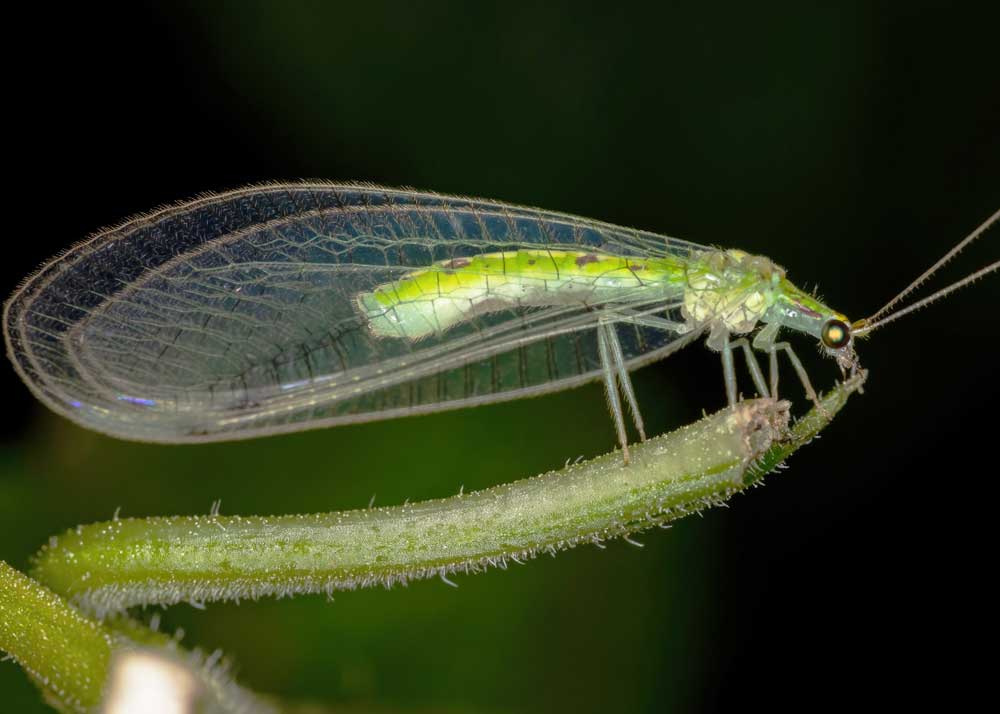
On the other hand, green lacewing larvae can grow up to a half-inch long. The larvae are brown and white, and they have two large pincers extending from their mouths.
In the larvae stage, green lacewings have ferocious appetites for many different insects with soft bodies.
Green lacewings are fantastic for controlling mites, caterpillars, thrips, whiteflies, mealybugs, and leafhoppers.
3. Praying Mantises
The praying mantis is a large insect, especially when compared with other insects on this list.
At two to four inches long, you’ll be hard-pressed to find many insects bigger than this.
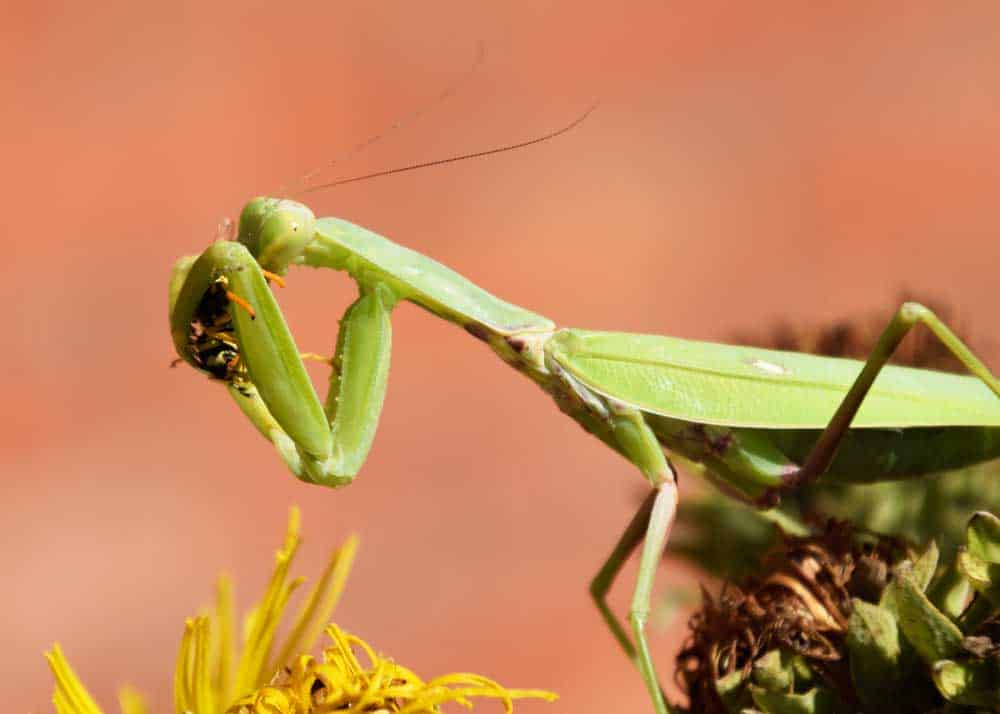
These insects eat a large number of pest insects. A praying mantises diet can consist of locusts, spiders, caterpillars, beetles, adult moths, wasps, and aphids.
Unfortunately, they’ll also eat beneficial insects, such as bees and butterflies.
You’ll need to weigh carefully if you want to attract this insect to your garden. And consider the effect it might have on your pollinator population.
4. Robber Flies (Asilidae)
It’s hard to miss a robber fly. They have a distinct appearance that’s much different from a traditional fly.
Robber flies have elongated bodies that extend beyond their legs, and their legs have bristles all over.
They also have a small hump on their back where their wings are, near the head. Robber flies are black or brown.
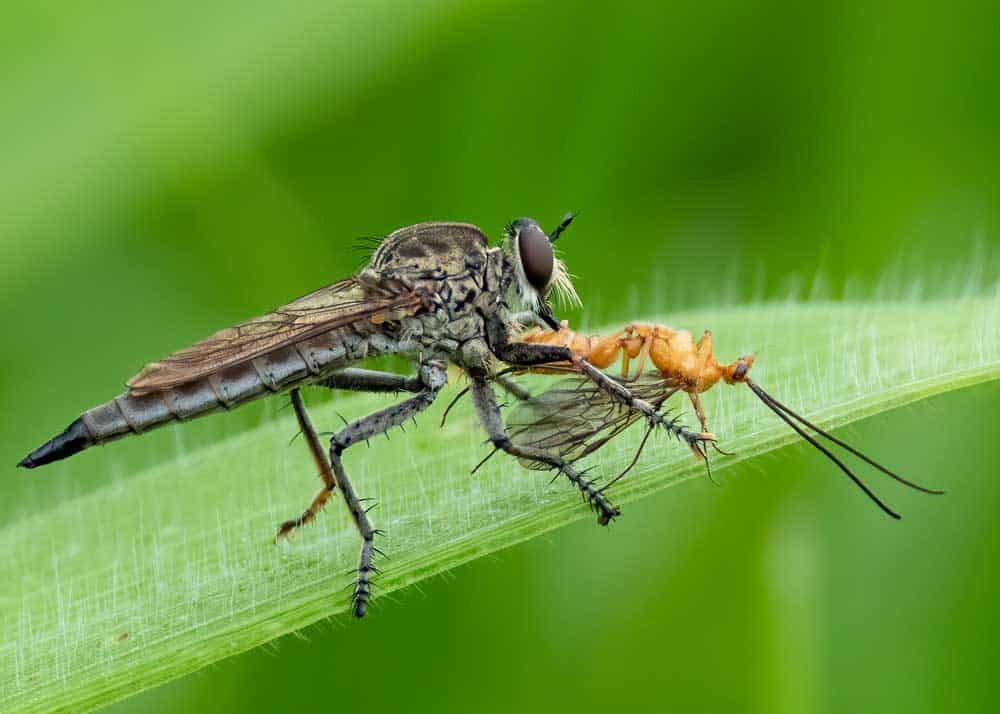
The robber fly will hunt a wide array of garden pests, like grasshoppers, grubs, leafhoppers, adult beetles, and some types of wasps and spiders.
It’s not good to have too many of them in your garden, as they also eat beneficial insects like butterflies and bees.
They are such good predators, that they are also called assassin flies.
5. Spiders
The most common house spiders and garden spiders are:
- Crab spider
- Grass spider
- Yellow garden spider
- Barn spider
- Different types of jumping spiders
- Wolf spider
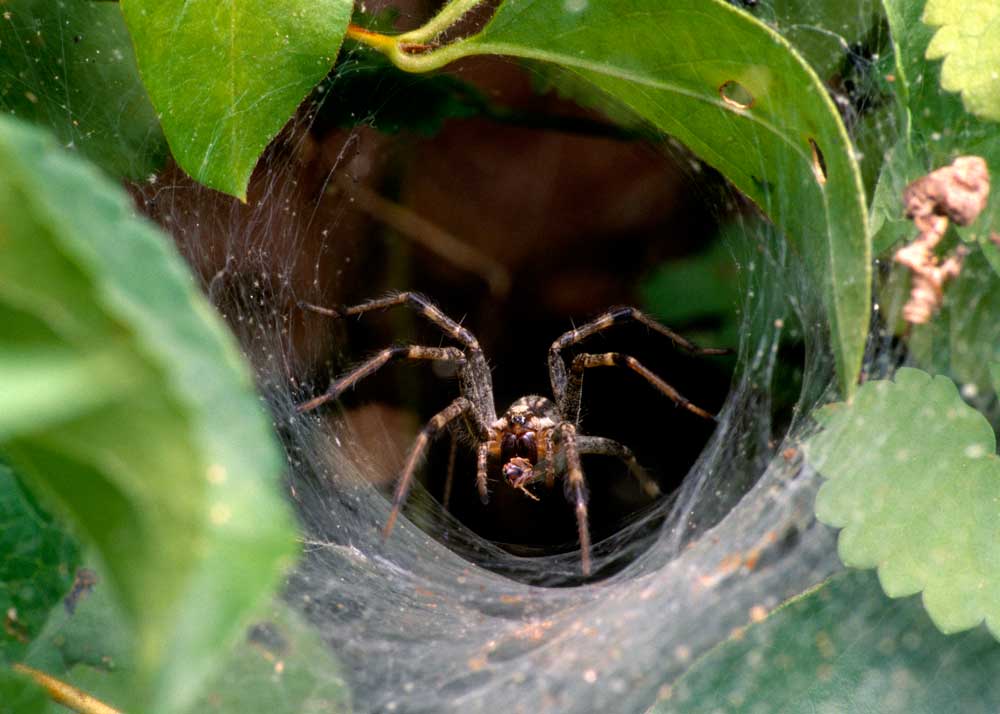
Note: These spiders on this list are not considered toxic to humans, even if they bite.
Although these species can vary, all spiders have two body sections, eight legs, and no antennae or wings.
You can find spiders in abundance in your garden, and many of them eat insects, including a large number of pests.
Spiders eat and control caterpillars, fruit flies, aphids, wasps, and grasshoppers.
Due to their sheer numbers, the downside is that they will also eat lots of beneficial bugs.
6. Ground Beetles
Predator bugs such as ground beetles have wings despite barely flying, and they generally stay out of sight for most of the day.
The adult ground beetles are shiny black and between ⅛-½ inch in length. You can also find some brightly colored, iridescent, or brown species.
It’s important not to confuse ground beetles with Japanese Beetles, which are pests in the garden.
As adults and even larvae, ground beetles feed on garden pests like weevils, caterpillars, silverfish, thrips, slugs, cutworms, snails, squash bugs, and cabbage maggots.
7. Pillbugs
The pillbug, better known in common vernacular as a “rolly poly,” is another helper that isn’t technically an insect. These critters are actually crustaceans like crab and shrimp.
Pillbugs have gray body segments which resemble armor-like plates, and when threatened, they’ll roll into a tight ball for protection.
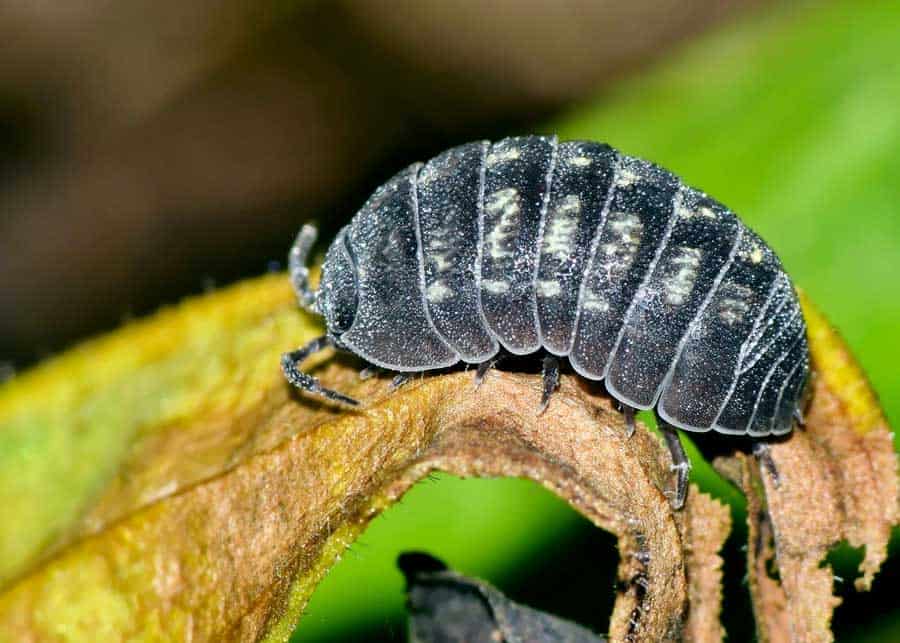
Pillbugs are approximately ½-inch long when they aren’t rolled up in defense mode.
Pillbugs behave similarly to earthworms. They aid in decomposing organic material such as leaves and dead plants.
This, in turn, places nutrients back into the soil for your plants and grass to absorb.
8. Predatory Mites
Predatory mites, like other species of mites, are not insects but arachnids. They are tiny, less than ½ mm long.
Their bodies are pear-shaped and are translucent until they eat something and turn reddish or orangish afterward. Predatory mites have longer legs and a rounder body than pest mites.
They eat members of their own family that are more troublesome, such as dust mites, spider mites, bulb mites, and other mites that eat the nutrients from your plants.
Allowing predatory mites into your garden can halt a pest mites infestation rapidly.
9. Hoverflies
Hoverflies, also known as syrphid flies, resemble a wasp or a bee. They are brown or black, and they have yellow stripes. They can be anywhere from ¼-¾ of an inch long.
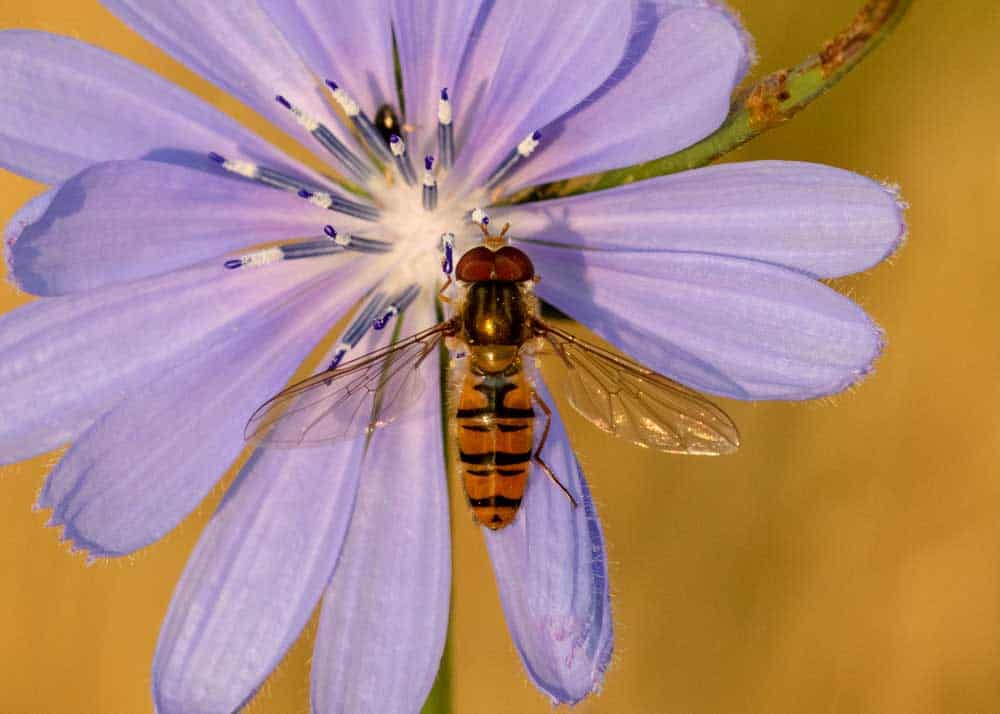
Some hoverflies are hairy, but you can tell the difference between them and a bee or wasp because they only have two wings and not four.
Not only do hoverflies pollinate plants, but the larvae eat aphids, beetles, caterpillars, thrips, beetles, mealybugs, and scale insects.
Here’s more in our Guide to Hover Flies.
3 Beneficial Insect Parasites
1. Tachinid Flies
Tachinid flies are gray or brown flies with dark bristles all over their bodies. They mostly resemble a common fly, but they have distinct habits.
The adults lay their eggs on beetles, caterpillars, and bugs near their heads.
When these eggs hatch, the maggots begin tunneling into the host. They will feed internally for at least seven days or more, and the larvae will eventually kill the pest.
Tachinid flies kill common pests like caterpillars, corn borers, grasshoppers, gypsy moth caterpillars, squash bugs, Japanese beetles, green stink bugs, and Mexican bean beetles.
Learn more about how tachinid flies target monarch caterpillars.
2. Braconid Wasps
Braconid wasps have a narrow waist like a typical wasp, and they can be of various colors from brown to red to yellow or black.
They usually have a dark blotch at the tip of their forewing. Their antennae are short, and you’ll notice that the abdomen is generally longer than their thorax and head combined.
In gardens, the braconid wasps hover around caterpillars and aphid colonies. They will lay eggs on caterpillar and tomato hornworms, forming a white cocoon.
Eventually, they will reproduce and continue to kill garden pests by sucking the life from the hosts.
3. Trichogramma Wasps
The Trichogramma wasps lay their eggs in the eggs of more than 200 garden pests like caterpillars and moths. They’re very little; about four or five can sit atop the top of a pin. When they lay their eggs inside of moth eggs, it keeps the moth from turning into a caterpillar.
Other garden pests that they typically combat are the cabbageworm, tomato pinworms, tomato hornworms, codling moth, corn borers, and many other insects that can destroy your yard.
5 Beneficial Insect Facts
These five facts are via CSU Extension.
Beneficial arthropods can prevent or limit pest problems in the yard and garden.
These “friends” can be categorized broadly as either insect predators or parasites.
Predators include lady beetles, lacewings and spiders.
Common insect parasites are the tachinid flies, the braconid and the ichneumonid wasps.
When insecticides are needed, choose ones that are selective and less likely to harm insect predators and parasites.
Colorado State University, Extension
Keep reading: What Eats Mosquitos? 15 Predators
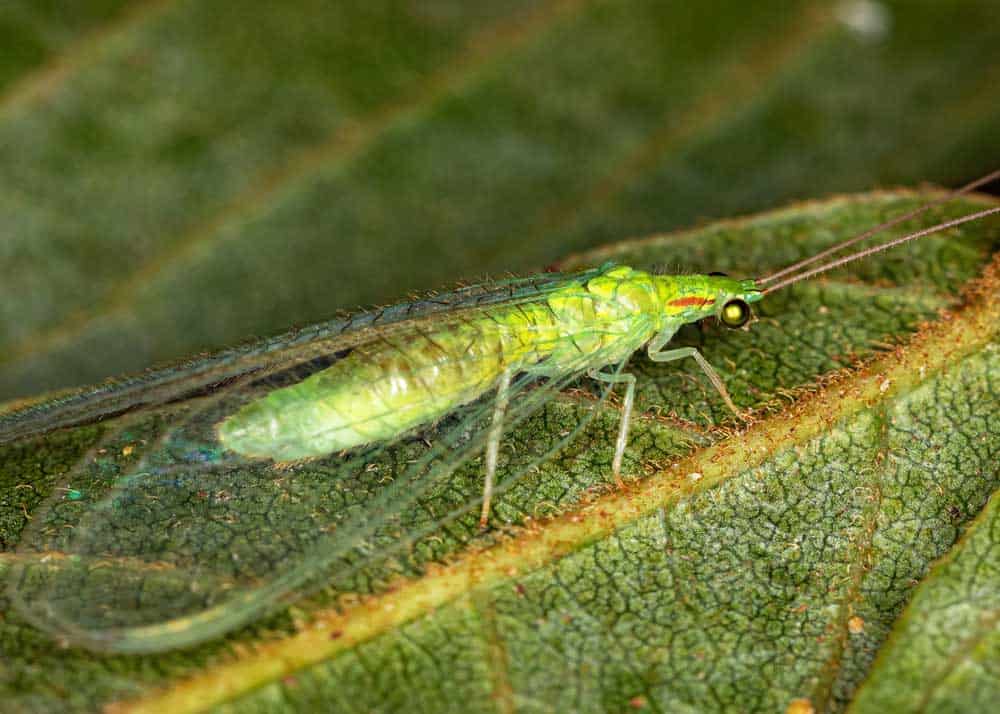
More reading: Guide to Tiny Black Biting Bugs
Your Turn
Have a question? Or maybe an addition to the list? Join me below!
- About the Author
- Latest Posts
Bryan Haines is a co-founder and writer at The Buginator. And is working to make it the best resource for taking back the outdoors from biting, stinging pests.
He also blogs about travel at Storyteller.Travel and photography at Storyteller Tech. Bryan is a partner at Storyteller Media, a publishing company he runs with his wife, Dena.
